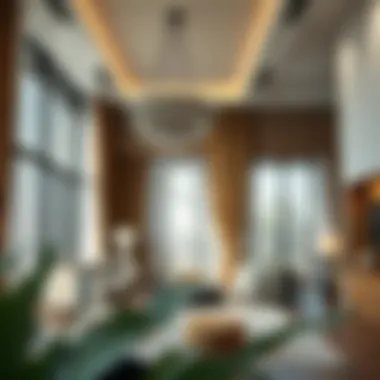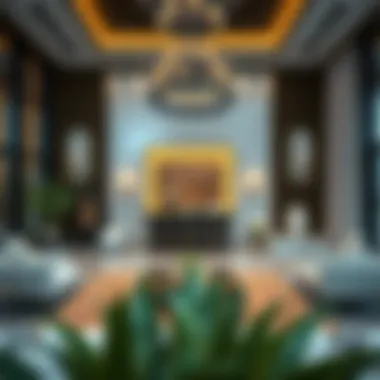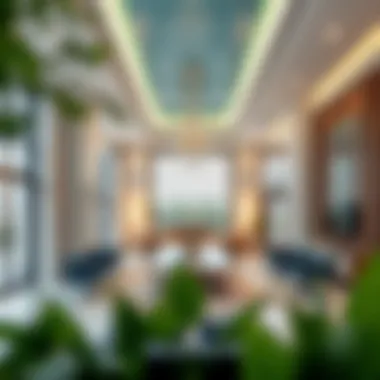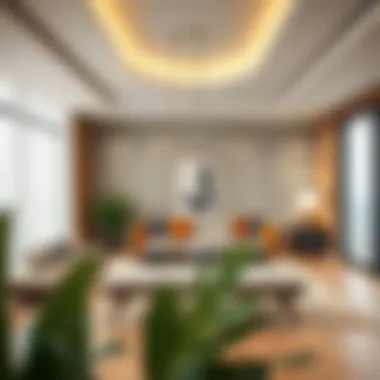Interior Design Companies in the UAE: A Comprehensive Overview


Intro
The interior design industry in the UAE represents a microcosm of creativity and commerce, blending diverse cultures and modern innovation. Within this bustling marketplace, interior companies play a pivotal role, driving not just aesthetic transformation but also economic growth. As urban centers like Dubai and Abu Dhabi thrive, the demand for well-designed spaces across residential, commercial, and hospitality sectors continues to rise.
This article aims to dissect the heart of this vibrant industry, exploring how interior companies adapt to ever-changing consumer preferences and regulatory landscapes. By examining the dynamics at play, we will provide insights that can empower investors, developers, and other professionals in making informed decisions. The aim here isn't just to scratch the surface but to delve into the nuances that shape the identity of interior companies within the UAE's architectural narrative.
Throughout this exploration, expect to uncover the current market trends, economic factors at play, and investment opportunities that can arise in this sector. With a keen eye on innovation, sustainability, and design philosophies, this comprehensive guide will illuminate the significant contributions of interior companies not just to individual spaces but to the greater urban ethos of the UAE.
Overview of Interior Companies in the UAE
The interior design industry in the United Arab Emirates (UAE) serves as a vibrant tapestry woven from diverse cultural influences, modern aesthetics, and rapid urban development. Understanding the role of interior companies in this context is crucial, especially for investors, real estate agents, and developers. These companies do not merely furnish spaces; they shape environments that reflect the UAE's unique identity, functionality, and luxury.
Historical Context
To truly appreciate the current landscape, one must reflect on the historical evolution of interior design in the UAE. From the simple, traditional designs that characterized the early emirati homes made of mud and palm fronds to the extravagant, glass-clad skyscrapers of today, the journey of interior companies mirrors the UAE's rapid modernization. This evolution began in earnest during the oil boom of the 1970s, when considerable wealth transformed the region.
Architects and designers began to merge global styles with local craftsmanship, establishing a new paradigm for interior spaces. As expats flocked to the Emirates, introducing their own design preferences, a fusion of East and West emerged, eventually leading to the contemporary design practices we see today. This rich historical backdrop not only adds depth to the companies operating today but also highlights their role as cultural curators and innovators.
Market Landscape
The marketplace for interior design in the UAE thrives under a unique blend of high demand and healthy competition. Major cities like Dubai and Abu Dhabi are home to a plethora of interior companies, ranging from small boutique firms to large international corporations. Each player brings something different to the table, resulting in projects that cater to various clients' preferences and budgets.
In recent years, the surge in real estate developments—especially in residential and commercial sectors—has fueled the industry's growth. Demand continues to soar, driven by expatriates, local investors, and international firms looking to establish a presence in the region.
Moreover, trends towards sustainability and technology integration are reshaping this landscape. Designers are increasingly focusing on creating eco-friendly spaces that do not compromise style. This evolving market landscape presents a myriad of opportunities for stakeholders to leverage innovative trends while enriching the living conditions for Emirati residents.
Key Industry Players
Identifying key players in the UAE's interior design scene provides insight into the competitive landscape. Prominent entities like Zen Interiors, Algedra, and Crown Interiors are leading the charge, each with their own distinct design philosophies and project portfolios.
- Zen Interiors: Known for its holistic approach, Zen fuses well-being with design, focusing on creating harmonious living spaces. Their attention to detail in both residential and commercial projects has earned them a loyal clientele.
- Algedra: This company concentrates on luxury design, showcasing opulent interiors that reflect a sophisticated lifestyle. Their expertise in creating bespoke solutions often sets trends within the industry.
- Crown Interiors: With a more pragmatic approach, Crown primarily serves commercial clients but is recognized for innovative space maximization techniques.
These companies, among others, not only define the aesthetic languages of their projects but also drive forward concepts that encourage collaboration and continuous innovation in the industry.
As we dig deeper into subsequent sections, it becomes clear that the interior companies of the UAE are not just building interiors—they are constructing the very narratives of modern Emirati life.
Key Sectors Served by Interior Companies
Interior companies in the UAE play a substantial role across a variety of sectors, each presenting unique challenges and opportunities. Understanding these sectors is crucial for investors and professionals looking to navigate this dynamic market effectively. Each sector is tailored to meet specific aesthetic and functional needs, ensuring they serve not only to beautify spaces but also to enhance functionality and usability.
Residential Interiors
Residential interiors encompass a broad range of services, from designing expansive villas to cozy apartments. The focus here is on creating spaces that feel like home while reflecting the individual styles of homeowners. In a country where diverse cultures meet, personalization becomes key. Homeowners often seek comfort, practicality, and warmth while integrating modern design trends.
As luxury in residential design becomes commonplace, the demand for high-end materials and creative spatial solutions rises.
- Customization: Clients typically appreciate tailored solutions. It's not just about buying a sofa or choosing a wallpaper; it’s about collaborating with design professionals who understand their vision and lifestyle.
- Sustainability: More clients today lean towards eco-friendly materials and practices. This trend aligns with a global movement towards sustainability. Incorporating energy-efficient appliances or opting for recycled materials can set a residence apart.


Key takeaway: The residential market thrives on personalization and sustainability, making it a lucrative focus for designers and investors.
Commercial Spaces
Commercial interiors can range from offices to retail spaces, and the design needs here often hinge on functionality and branding. Businesses require environments that are not only aesthetically pleasing but also conducive to workflow and client interaction. As companies adapt to ever-changing business landscapes, the conventional office space is being redefined to promote collaboration and innovation.
- Flexible Design: Open floor plans and adaptable furniture solutions are trending. The goal is to create spaces that can easily shift to meet the dynamic needs of businesses.
- Branding Through Space: Companies are increasingly recognizing the importance of using interior design to enhance their brand identity. This might involve specific color schemes or layouts that resonate with their target audience.
Key takeaway: The commercial sector emphasizes the balance of aesthetics and functionality, providing significant room for innovative design companies to thrive.
Hospitality Design
The hospitality design sector covers hotels, restaurants, and even resorts. This segment is all about guest experience. A well-designed space must not only entice guests but also cater to their diverse requirements, enhancing comfort while making a memorable impression.
- Thematic Concepts: Many hospitality venues adopt specific themes that influence design decisions. From luxury resorts echoing traditional aesthetics to modern eateries, the concept should be cohesive and engage the customer. The challenge lies in marrying aesthetics with practicality, ensuring that the space works seamlessly during peak operational times.
- Cultural Sensitivity: In a multicultural region like the UAE, understanding local customs and preferences is paramount for hospitality designs. This involves integrating local elements or materials that resonate with visitors.
Key takeaway: Hospitality design is an art. It demands creativity paired with a deep understanding of consumer behavior, setting the stage for rewarding investment opportunities.
The interplay between cultural respects and innovative design defines the UAE’s hospitality landscape. Understanding this balance is crucial for success in the sector.
Through these sectors, it’s evident that interior companies must wear many hats. They need to be adaptable, innovative, and culturally aware while also balancing functionality and aesthetics in their designs. Each sector has unique demands, yet they all converge in aiming to improve the human experience within designed spaces.
Design Trends Influencing the Market
The design trends shaping the interior companies in the UAE have become a focal point for industry stakeholders. Understanding these trends is paramount for real estate agents, investors, homebuyers, advisors, and developers alike. These trends are not just fleeting whims but pivotal innovations that reflect the desires of consumers and the socio-economic context of the region. A firm grasp on current trends empowers industry players to align their offerings with client expectations and market demands.
Sustainable Design Practices
Sustainability is not merely a buzzword; it's a significant design practice influencing interior companies in the UAE. As the effects of climate change become increasingly evident, clients look for solutions that are both functional and environmentally friendly. Sustainable design plays a role in reducing energy consumption by utilizing materials and systems that are eco-efficient.
- Materials: Clients are opting for reclaimed wood, recycled metals, and low-VOC paints. Such materials benefit the environment and contribute to healthier indoor air quality.
- Energy Efficiency: Designs that incorporate natural light through strategic window placement and the use of solar energy systems are gaining traction.
- Waste Management: Firms are focusing on minimizing waste during construction and renovations, emphasizing the importance of an efficient supply chain management.
By embracing sustainable practices, interior companies can attract eco-conscious clients, enhancing their market presence and brand image.
Technology Integration
The advent of smart technology is transforming the way spaces are designed and utilized. Integration of tech solutions not only enhances functionality but also aligns with modern lifestyle trends. From automated lighting and temperature controls to advanced home security systems, technology is weaving itself into the fabric of interior design.
- Smart Homes: The rise of smart homes is evident in the demand for integrated systems that control lighting, heating, and security. Homebuyers increasingly prefer residences equipped with technology that can be easily managed via a mobile app.
- Virtual Reality: Some interior companies now use VR to help clients visualize their spaces before any physical work begins. This saves time and resources while providing clients with a more engaging design experience.
- Sustainability through Tech: Innovative technology also aids in reducing energy consumption through smart appliances that adjust usage based on real-time data.
Incorporating these technological advancements not only meets client expectations but also sets companies apart in a competitive market.
Cultural Influences
The rich cultural tapestry of the UAE significantly informs design trends. With a blend of tradition and modernity, interior design here reflects both local heritage and global influences. This multifaceted approach to design creates a unique market that appeals to diverse consumer bases.
- Local Heritage: Many companies are drawing inspiration from Emirati traditions. Incorporating motifs and materials that reflect local culture can elevate spaces in a way that resonates with clients and visitors alike.
- Global Aesthetics: As expatriates comprise a significant portion of the population, international styles have also found a home in UAE interiors. This blend of East and West creates a dynamic design language, providing clients with options that suit varying tastes.
- Hybrid Spaces: The design of spaces that can serve multiple functions is gaining popularity. This is a response to the needs of both families and companies looking for flexible environments that can adapt to changing uses.


Overall, an understanding of cultural influences allows interior companies to craft designs that not only appeal aesthetically but also create a sense of belonging.
Knowing what drives consumer preferences in design trends is a game-changer for businesses wanting to thrive in this fruitful industry.
Regulatory Framework Affecting Interior Design
The regulatory framework governing interior design in the UAE plays a pivotal role in shaping the industry. It establishes standards that ensure safety, sustainability, and aesthetic integrity in the diverse environments across the Emirates. Understanding these regulations is crucial for industry players, from designers to investors, as they navigate the often complex landscape of development and renovation within this vibrant region.
Licensing Requirements
In the UAE, licensing requirements for interior designers ensure that practitioners meet professional standards. Each Emirate has its own set of regulations, often governed by local municipalities or ministries. For instance, in Dubai, the Department of Economic Development mandates that interior design firms obtain a trade license alongside professional certifications. This is a way to guarantee that only qualified individuals manage complex design projects.
Licensing typically involves:
- Educational qualifications: Designers usually must have a relevant degree from an accredited institution.
- Professional experience: A certain number of years working under licensed professionals may be required.
- Examinations: In some cases, passing specific examinations demonstrates knowledge of local regulations and design principles.
Acquiring the appropriate licenses not only enhances a firm’s credibility but also provides clients with peace of mind, knowing that their projects are in capable hands.
Building Codes and Standards
Building codes in the UAE are stringent and meticulously enforced to safeguard occupant safety and structural integrity. These codes dictate everything from fire safety measures to materials used in construction. Interior design companies must be well-versed in these regulations to achieve compliance during project execution.
Key points of consideration include:
- Safety regulations: Codes specify fire-resistant materials, emergency exits, and accessibility features, which are non-negotiable in design plans.
- Environmental standards: Many codes are increasingly emphasizing sustainable practices, guiding firms toward eco-friendly materials and energy-efficient designs.
- Cultural considerations: Local aesthetics and cultural nuances can influence design standards, prompting firms to adapt their visions to resonate with regional identity.
"Adhering to these building codes is not just about compliance; it's about fostering trust and reliability within the community, which, in the long run, enhances brand loyalty."
Ultimately, understanding the regulatory framework affecting interior design is essential for sustaining growth and innovation in the UAE's dynamic market. These laws not only protect public safety but also outline a clear pathway for professional practice in this competitive industry.
Consumer Preferences and Behavior
Understanding consumer preferences and behaviors is crucial for interior companies navigating the competitive landscape of the UAE. The tastes of clients not only determine the styles and functionalities of spaces but also influence the entire decision-making process around design, procurement, and execution. As cities like Dubai and Abu Dhabi continue to grow, the demands on interior companies shift, making it essential to keep a pulse on what clients desire.
Demographics of Clients
The demographic profile of clients is complex in the UAE, a melting pot of cultures and lifestyles. Residents range from affluent expatriates to local Emiratis. Each group brings distinct preferences that shape their demands for interior design.
- Expatriates often lean toward contemporary and minimalist styles, reflecting trends from their home countries. They appreciate functionality but do not shy away from indulgent elements.
- Local Emiratis, conversely, might favor designs that pay homage to traditional Arabic aesthetics, emphasizing warmth, richness in color, and intricate patterns.
Moreover, age demographics also play a role. Younger homebuyers may prioritize technology integration and sustainability, while older generations might be more focused on comfort and luxury.
Emerging Trends in Client Needs
With the ever-evolving market, specific trends continue to sprout from client needs. Here are some notable shifts:
- Sustainability: Clients increasingly demand environments that are not only visually appealing but also eco-friendly. This trend is pushing interior companies to adopt sustainable materials and practices, from sourcing to execution.
- Smart Homes: With technology on the rise, homeowners are looking for solutions that integrate smart systems into their interiors, facilitating connectivity and efficiency.
- Personalization: Clients want their spaces to reflect their individuality. This shift toward personalized interiors, where unique elements tell a story or evoke specific memories, prompts interior firms to pay closer attention to client interests.
- Multi-Functional Spaces: As lifestyles adapt to changing work and leisure patterns, there is a growing need for multi-purpose areas. This trend has gained traction, especially among professionals working from home who require versatile spaces.


The understanding of consumer preferences is more than just a marketing strategy; it’s integral to the design process in the UAE.
As interior companies keep tabs on these emerging trends and demographic shifts, they can better tailor their services, enhancing customer satisfaction and ultimately driving sales. This alignment with client preferences directly contributes to building a reputable brand in the highly competitive UAE market.
Challenges Faced by Interior Companies
In the ever-evolving landscape of interior design within the UAE, companies encounter various hurdles that can significantly impact their operations and growth prospects. Understanding these challenges is crucial for stakeholders, ranging from investors and real estate agents to interior designers and clients. This section delves into the touchy economic factors and supply chain issues, shedding light on how they shape the industry.
Economic Factors
Economic conditions play a massive role in determining the success of interior companies in the UAE. When the economy is booming, one could say that the sky's the limit; however, downturns might force many firms to tighten their belts. Fluctuations in the real estate market can directly influence demand for interior design services.
Here are several key aspects to consider:
- Market Demand: A high demand for luxury residences often coincides with economic prosperity, leading to increased projects for interior companies. Conversely, economic slowdowns can result in a decrease in new projects, which can severely impact revenue streams.
- Investment Trends: International investments can either spur innovation in design or lead to market instability. For instance, if investors retreat during economic uncertainty, many interior companies may struggle to find funds for development.
- Cost of Materials: When the economy shifts, so too can the cost of design materials. Interior companies often face rising costs for wood, textiles, and other essentials, cutting into profit margins. Those fluctuations can make it difficult to provide consistent pricing to clients, sometimes leading to strained relationships.
Understanding these factors allows interior companies to adapt their business strategies accordingly.
Supply Chain Issues
In today’s world, the complexities of a global supply chain can’t be ignored. Interior companies in the UAE must navigate these waters carefully, as delays can lead to project overruns, cost increases, and dissatisfied clients.
Key challenges related to supply chains include:
- Logistical Delays: Transportation setbacks, be it from natural disasters or political unrest, can lead to significant delays in obtaining materials. Companies might find themselves caught between a rock and a hard place when clients demand timely completions and suppliers fail to deliver.
- Quality Control: Often, sourcing materials from diverse global suppliers can lead to inconsistencies in quality. A freshly sourced oak might look lovely in the showroom but fail to meet expectations when it arrives on-site.
- Compliance and Regulations: Import regulations can complicate the logistics of bringing necessary materials into the UAE. Interior companies need to stay informed about laws to avoid compliance pitfalls that could affect their timelines and budgets.
"Navigating the supply chain is like walking a tightrope; one misstep can send a project crashing down."
In summary, focusing on the economic factors and supply chain issues presents both challenges and opportunities for interior companies. By proactively managing these elements, businesses can enhance their resilience and better prepare for the ever-changing dynamics of the UAE market.
Future of Interior Companies in the UAE
In the landscape of interior design, the future of companies in the UAE signifies a realm of potential and change. As the nation continues to grow, driven by economic diversification and urban development, interior companies are increasingly positioned as key players in this evolving narrative. Understanding this future is crucial for investors, developers, and real estate professionals eager to navigate the competitive market. This section explores what lies ahead for the industry, focusing on market forecasts and forthcoming innovations that will shape the sector’s trajectory.
Market Forecasts
The market forecasts for interior companies in the UAE suggest a promising outlook. By considering factors such as population growth and an influx of expatriates, one can see a surge in demand for both residential and commercial spaces. This need is further fueled by a burgeoning real estate sector, thanks in part to the introduction of new regulations that foster a conducive environment for foreign investments.
Some key points to consider in these forecasts include:
- Increasing Urbanization: The shift toward urban areas continues, with cities like Dubai and Abu Dhabi seeing rapid expansion in housing developments and infrastructure projects.
- Hospitality Industry Boom: With major events like Expo 2020 (which has been delayed to 2021) set to enhance tourism, there’s a growing need for improved hospitality spaces. Interior companies are likely to step up to meet this demand.
- Sustainable Practices: As sustainability grows in significance, consumers and companies alike are looking toward eco-friendly designs, thus creating opportunities for those specializing in green interior solutions.
"By 2025, it’s expected that the interior design market's annual growth rate could reach up to 6%."
These statistics point to a land of opportunities where designers can thrive by plugging into these growth currents, tailoring their services to meet changing needs in diverse market segments.
Innovations on the Horizon
Innovation is at the heart of the future of interior companies in the UAE. As technology advances, the opportunities to enhance design and functionality are boundless. A few noteworthy trends that show potential include:
- Smart Home Technologies: Integration of IoT into residential and commercial spaces is becoming a norm. Companies are expected to adopt technologies that allow for automated lighting, climate control, and security features, making spaces more modern and user-friendly.
- Virtual and Augmented Reality: These tools are revolutionizing how interior design is presented to clients. By offering immersive experiences, clients can visualize their spaces before the physical work begins, significantly reducing the margin for error and increasing satisfaction.
- 3D Printing and Customization: Technologies like 3D printing are paving the way for bespoke furniture and fixtures. Interior companies that harness this tech can provide tailor-made solutions, resonating well with consumers looking for personalization in design.
- Sustainable Materials: The use of recycled and sustainable materials is not just a trend but a movement. Think bamboo, reclaimed wood, and low-impact paints. Clients are increasingly drawn to companies that prioritize environmental responsibility in their interior offerings.
In summary, the future of interior companies in the UAE is bright, brimming with opportunities for those who can adapt and innovate. Forecasts point toward substantial growth, while innovations signal a transformative shift in how interior spaces are designed and utilized. The discerning investors and developers who recognize these trends will undoubtedly find themselves at the forefront of this thriving industry.







